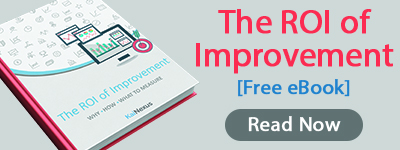 One of the core principles of continuous improvement is that decisions are made based on data. Practitioners don’t just rely on anecdotal stories about how work is performed, they go to the source and directly observe. They don’t just act, they study continuous improvement data. That’s why we are surprised at how often organizations don’t have a plan in place for collecting data about the improvement process itself.
One of the core principles of continuous improvement is that decisions are made based on data. Practitioners don’t just rely on anecdotal stories about how work is performed, they go to the source and directly observe. They don’t just act, they study continuous improvement data. That’s why we are surprised at how often organizations don’t have a plan in place for collecting data about the improvement process itself.
Why It’s Important to Collect Data about Continuous Improvement
There are lots of reasons to capture the details of your continuous improvement efforts in real time. Here are just a few:
To Speed Progress: Like any project, improvement initiatives move more quickly if everyone has the information they need to take the next step.
To Improve Improvement: Understanding what doesn’t work well is just as important as understanding what does. Analyzing each improvement project helps successful organizations build on past successes and avoid potential pitfalls.
To Justify Investment in Improvement: Most continuous improvement efforts are extremely profitable even if they require some investment. In fact, in a study of our customers, we found that cost savings are the most common result of improvements. But in order to demonstrate the significant ROI of improvement, both the costs and results must be tracked.
To Encourage Engagement: Giving a shout out to people who made an impact through improvement is a great way to boost engagement, but to do that, you have to know what that impact is. It's not just the impact that should be measured, though - knowing who is participating and who isn't (both on the individual and department level) helps leaders know where to focus their coaching efforts.
How to Collect Data about Continuous Improvement
Adopt CI Software: Continuous improvement software provides the structure for data collection and analysis. Unlike email and spreadsheets, it is designed to serve as a repository for tribal knowledge and to move improvement activities along with automated workflow and notifications.
Remove Barriers: Make sure that the solution you select is available from wherever employees happen to be, and on the device of their choice. It should be easy to use, yet robust enough that the perceived value will be high.
Incentivize Employees to Contribute Data: Of course software solutions are only useful if employees supply timely and accurate information. Recognizing and rewarding employees who contribute to improvement and keep records up to date goes a long way in ensuring adoption of technology.
I’m sure you’ve heard it 1000 times, but it’s worth repeating: that which gets measured, improves. This is true for your business process and for the practice of improvement itself. With a little planning, the right tools, and the engagement of your employees, collecting data about improvement is painless and priceless.



Add a Comment